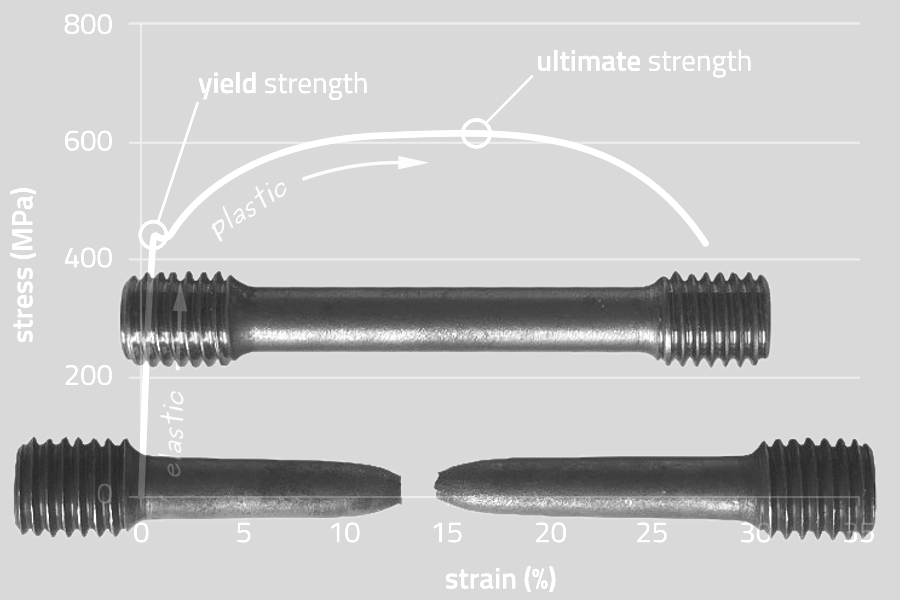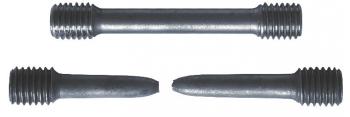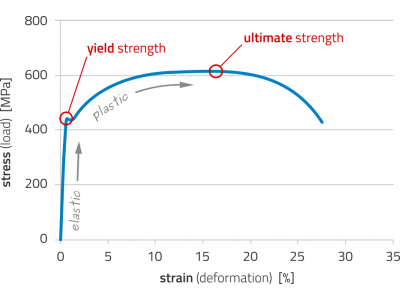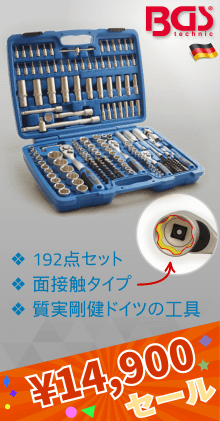What exactly is strength?

| Image | The image above shows a tensile testing sample before and after the test. |
What is this about?
In this post we talk about material strength, how it is defined and how it is measured. We discuss about the difference between yield strength and ultimate strength. These two limits indicate how ductile or brittle a materials is.
Definition:
| The strength of a material is its ability to withstand an applied load without failure or permanent deformation. [Wikipedia] |
To determine the strength of a material a test rod like the one shown in the image above, is pulled on both ends. First the rod will deform elastically like a spring. That means if the load is removed the rod returns to its original length. If the load is further increased at some point the metal will yield and start to flow. This means plastic deformation takes place. If the load is removed now the rod will stay permanently deformed. If the load is even more increased the test rod will eventually break completely.
As a consequence, there are two important strength limits for metals:
- Yield strength
- Ultimate strength
Example: basic construction steel
Let's look at an example: basic construction steel (JIS SS490, or S355). The evolution of load and deformation is shown in a stress-strain diagram (CLICK the diagram below to enlarge it). Stress or load is plotted on the vertical axis and the strain or deformation on the horizontal axis.
The diagram above shows real measurement data which are plotted in true scale. In the internet you usually find approximative sketches. What is interesting to see from true scale is that the deformations during the initial elastic phase (the straight and almost vertical line on the left) are very, very small compared to the plastic deformation after exceeding the yield point. This behavior is typical for ductile metals.
Yield strength vs. Ultimate strength – What's the difference?
The most important point is to clearly understand the difference between yield strength and ultimate strength:
| Yield strength: |
|---|
|
The yield strength is the border between elastic and plastic (permanent) deformation. When the yield strength is exceeded, permanent plastic deformation occurs (=damage). Below the yield strength the metal behaves like a spring and all deformations are elastic. |
| Ultimate strength: |
|
If the yield strength has been exceeded and the material undergoes plastic deformation, its strength keeps increasing for some time. This effect is called work hardening. The ultimate strength is the point where the highest load (=strength) occurs. |
The best difference between yield strength and ultimate strength let's think of a beam carrying a load. Below the yield strength the beam will deform under load but there will be no damage. If the load is increased to the ultimate strength the beam will bend permanently but will not break. Beyond ultimate strength the beam can not hold the load and will break quickly.
How is strength measured?
Testing the strength of a material requires to produce test samples like the one shown below:
| Before: |

|
| After: |
The samples are then tested until complete failure. During testing the loads and deformations are recorded and the results are used to produce stress-strain diagrams like the one above.
Below is a short 10 sec video clip of a tensile test – please hit the "play" button
Summary
It is important to understand what metal strength means. Between unhardened construction steels and highest strength steels the ultimate strength of steels can vary up to a factor 10! Also tool steels can largely vary in strength depending on manufacturer and product.
More related stories:
If you are interest to read more, please check out some of the following blog posts:
Like this post? Please share!
If you like this post and think others might find it useful too, please share it on Facebook, Twitter etc.
Questions? Comments?
If you have questions or comments, please leave us a comment below. We really like to hear back from you! Getting feedback is what keeps us going to write many more articles.
0 Comment
Leave a Comment
Your email address will not be published. Required fields are marked *













![[ Stahlwille ]](https://gizzet.com/en/media/wysiwyg/banners/stahlwille_aerospace_A01_en.png)




